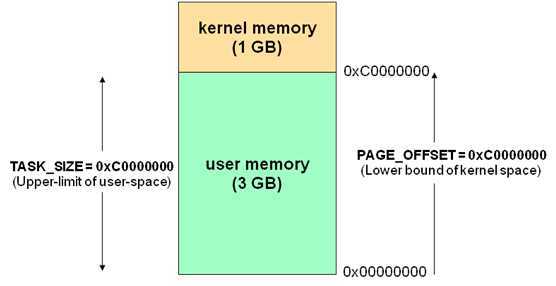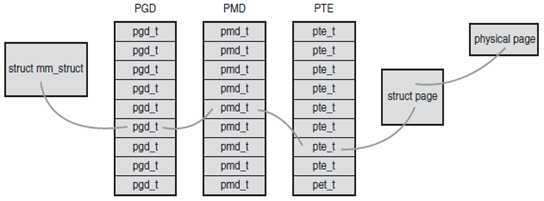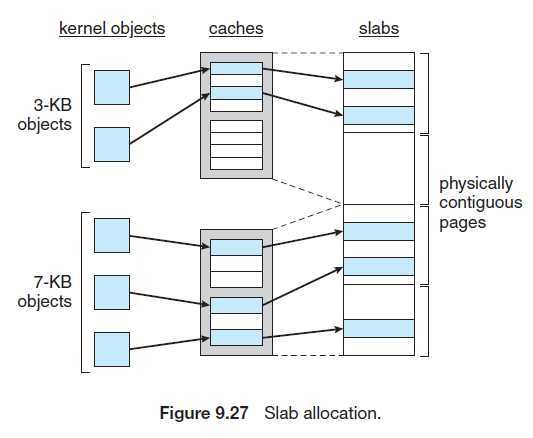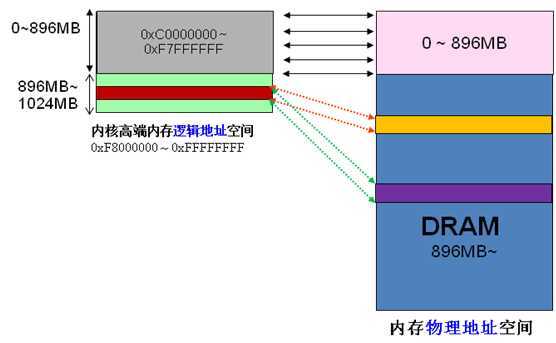标签:des blog http io os 使用 ar for 文件
When a process running in user mode requests additional memory, pages are allocated from the list of free page frames maintained by the kernel. This list is typically populated using a page-replacement algorithm such as those discussed in Section 9.4 and most likely contains free pages scattered throughout physical memory, as explained earlier. Remember, too, that if a user process requests a single byte of memory, internal fragmentation will result, as the process will be granted an entire page frame. Kernel memory is often allocated from a free-memory pool different from the list used to satisfy ordinary user-mode processes. There are two primary reasons for this:
通常32位Linux内核虚拟地址空间划分0~3G为用户空间,3~4G为内核空间(注意,内核可以使用的线性地址只有1G)。注意这里是32位内核地址空间划分,64位内核地址空间划分是不同的。

每个进程的页面目录就分成了两部分,第一部分为“用户空间”,用来映射其整个进程空间(0x0000 0000-0xBFFF FFFF)即3G字节的虚拟地址;第二部分为“系统空间”,用来映射(0xC000 0000-0xFFFF FFFF)1G字节的虚拟地址。可以看出Linux系统中每个进程的页面目录的第二部分是相同的,所以从进程的角度来看,每个进程有4G字节的虚拟空间, 较低的3G字节是自己的用户空间,最高的1G字节则为与所有进程以及内核共享的系统空间。
由程序员通过 INT指令触发。cpu把软中断做为陷阱来处理,也叫编程异常,其中int 0x80可以用于执行系统调用,int3则主要用于设置断点(对程序进行调试)。
linux采用虚拟内存管理技术,每一个进程都有一个3G大小的独立的进程地址空间,这个地址空间就是用户空间。每个进程的用户空间都是完全独立、互不相干的。进程访问内核空间的方式:系统调用和中断。
创建进程等进程相关操作都需要分配内存给进程。这时进程申请和获得的不是物理地址,仅仅是虚拟地址。
实际的物理内存只有当进程真的去访问新获取的虚拟地址时,才会由“请页机制”产生“缺页”异常,从而进入分配实际页框的程序。该异常是虚拟内存机制赖以存在的基本保证,它会告诉内核去为进程分配物理页,并建立对应的页表,这之后虚拟地址才实实在在的映射到了物理地址上。


linux中使用三级页表完成地址转换。多数体系结构中,搜索页表的工作由硬件完成。在上面这个图中,顶级页表是页全局目录(PGD),二级页表是中间页目录(PMD).最后一级是页表(PTE),该页表结构指向物理页。上图中的页表对应的结构体定义在文件asm/page.h中。为了加快查找速度,在linux中实现了快表(TLB),其本质是一个缓冲器,作为一个将虚拟地址映射到物理地址的硬件缓存,当请求访问一个虚拟地址时,处理器将首先检查TLB中是否缓存了该虚拟地址到物理地址的映射,如果找到了,物理地址就立刻返回,否则,就需要再通过页表搜索需要的物理地址。
中文翻译就是个坑,前几天舍友问我什么是快表?我表示不知道。网上一查才知道原来是TLB.
摘自:http://www.cnblogs.com/bizhu/archive/2012/10/09/2717303.html

A slab is made up of one or more physically contiguous pages.A cache consists of one or more slabs. There is a single cache for each unique kernel data structure.
The slab allocator first attempts to satisfy the request with a free object in a partial slab. If none exists, a free object is assigned from an empty slab. If no empty slabs are available, a new slab is allocated from contiguous physical pages and assigned to a cache; memory for the object is allocated from this slab.
The slab allocator provides two main benefits:
Beginning with Version 2.6.24, the SLUB allocator replaced SLAB as the default allocator for the Linux kernel. SLUB addresses performance issues with slab allocation by reducing much of the overhead required by theSLAB allocator
x86架构中将内核地址空间划分三部分:ZONE_DMA、ZONE_NORMAL和 ZONE_HIGHMEM。ZONE_HIGHMEM即为高端内存,这就是内存高端内存概念的由来。
ZONE_DMA 内存开始的16MB
ZONE_NORMAL 16MB~896MB
ZONE_HIGHMEM 896MB ~ 结束(1G)
当内核想访问高于896MB物理地址内存时,从0xF8000000 ~ 0xFFFFFFFF地址空间范围内找一段相应大小空闲的逻辑地址空间,借用一会。借用这段逻辑地址空间,建立映射到想访问的那段物理内存(即填充内核PTE页面表),临时用一会,用完后归还。这样别人也可以借用这段地址空间访问其他物理内存,实现了使用有限的地址空间,访问所有所有物理内存。

用户进程没有高端内存概念。只有在内核空间才存在高端内存。用户进程最多只可以访问3G物理内存,而内核进程可以访问所有物理内存。
目前现实中,64位Linux内核不存在高端内存,因为64位内核可以支持超过512GB内存。若机器安装的物理内存超过内核地址空间范围,就会存在高端内存。
摘自:http://blog.csdn.net/trochiluses/article/details/9297311
标签:des blog http io os 使用 ar for 文件
原文地址:http://www.cnblogs.com/linyx/p/3998847.html